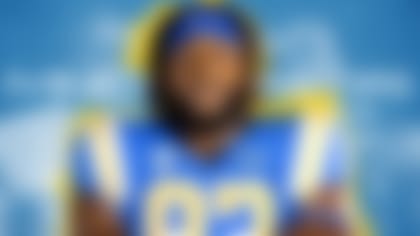The topic of law enforcement and race is a sensitive one for many Americans, but for Chase Young and his family, it hits particularly close to home
By Chase Goodbread | Published April 16, 2020
The common area in the lobby of the apartment complex carries an ultra-contemporary decor, with steel-framed seating that doesn't quite match -- a blue fabric couch paired with tan and gold leather chairs -- modern artwork and carpeting you wouldn't notice unless you spilled something.
It couldn't be cleaner, or the furniture more precisely arranged, but there is no warmth to it. No heart.
Not until the Young family -- former Ohio State star defensive end Chase Young, his parents Greg and Carla, and sister Weslie -- pull into the cold, adjacent parking garage, walk through the glass doors of the complex where Weslie lives and gather for what is unmistakably a kitchen-table conversation. The subject is one that reverberates around kitchen tables all over America: the relationship between law enforcement and the African-American community.
Is it merely fragile, or fractured?
Fractured, or shattered?
That can depend upon where one lives, whom one asks, or, ultimately, how one perceives. High-profile cases of people of color being killed and mistreated by police formed a harrowing narrative that spawned the Black Lives Matter movement and compelled former San Francisco 49ers quarterback Colin Kaepernick to raise awareness of the issue by kneeling during the national anthem.
The Youngs have a unique perspective on the subject as an African-American family with a deeply-rooted history in law enforcement. Chase Young grew up around that history. But personal experience, including an incident in which he believes he was the subject of racial profiling, has shaped his views on the topic right along with his upbringing. He sees the problem somewhat differently, as a young, black 21-year-old, than the generation that raised him.
Young has come home to Maryland a few days before Christmas, a brief respite from football after having logged most of the Buckeyes' preparation for what turned out to be his final college game, a 29-23 loss to Clemson in a College Football Playoff semifinal. There couldn't have been more on his football plate at the time, with Clemson on deck and a final choice of an agent looming in the weeks ahead. But that decision belonged in a real kitchen, not here, in an impersonal setting, with the occasional stranger shuffling by. Wearing a gray Ohio State sweatshirt, he folds his massive, 6-foot-5 frame into the gold chair as he and his family gather around a glass-top table. It's adorned by a free-floating lattice sculpture that looks like some atomic configuration out of a chemistry textbook, delicate as could be.
Appropriate for a delicate conversation.
The Youngs tackle it head-on.
Sitting in Greg Young's lap wasn't too difficult, but falling asleep wasn't going to happen. He was in full uniform, and not far from retirement with the Arlington County (Va.) Sheriff's Department, in one of Chase Young's earliest memories being intrigued by his father's job.
"You couldn't lay down on him because stuff on his shirt would be sticking you," Young said. "He had all these clips on his shirt and the badge. That's what sparked it."
Greg, who quelled Chase's interest in his gun by letting him handle it unloaded, was never short of stories to tell from his role working in the county jail.
Chase couldn't help but take an interest in law enforcement.
His father put in 22 years, and his mother worked in the Department of Transportation's Office of Investigations, which fights fraud and other crimes related to the DOT. His uncle, Bernard Joseph, put in 20 years in the Prince George's (Md.) County Police Department, and two other uncles, plus two cousins, made careers of policing as well. Altogether, there are 144 years of law enforcement experience in the family, spanning an incredibly diversified list of agencies and every imaginable role -- patrol cop, correctional officer, hostage negotiator, narcotics investigator, bailiff, college police chief and more. They've seen the shift in race relations first-hand in a way few could fathom. In 1971, Chase's uncle Von was set to become the first black police officer in Lincoln, Illinois, with a hire date of April 1, but, as he was later told by his chief, city officials postponed his hiring by a day, to April 2, because they feared citizens might consider it an April Fool's joke.
Four houses away from the Young home, during his time as an undercover narcotics investigator, Joseph would regularly pull into the driveway with a different unmarked police car. Changing cars was good for maintaining his cover, and Chase had something of a fascination with what Joseph would drive home next.
"Chase wanted to know what every single gadget in the police car was. He wanted to know everything on your utility belt," Joseph said in a phone interview. "He's always been that kind of kid. The excitement of the job has always drawn him. I don't think he'll ever have a 9-to-5 behind a desk."
There's nothing 9-to-5 about pro football, and the NFL can't wait to hire him. NFL scouts view Young as an early selection in the first round, and a cornerstone talent for any defense in need of pass-rush help. As one of the draft's elite talents, he's on the brink of generational wealth, and football is understandably his only real focus. But he's given plenty of thought to his post-football career, as well, and he's not as interested in policework as he was as a child.
"He did want to be a cop," his uncle Kenny said by phone. "But I think all the negative stuff he sees in the media now might've changed his mind a little bit."
A father's story ...
It's been some 20 years now, but Greg Young remembers his worst brush with police misconduct with an easy clarity. He was off duty and driving near the 14th Street bridge complex that connects Washington D.C. to Arlington, Virginia, when he recalls being pulled over by the United States Park Police, ordered to get out of his vehicle, and slammed against the car without explanation.
Instead of identifying himself as a fellow officer, however, Young opted to stay silent, just to see how severely his rights would be violated. He was taken into custody without being told why and driven to the police station.
"I let him take me all the way down, and they went in my pocket and found my badge, and I saw everybody's head turn, like, 'Whoa, this shouldn't have happened,' " Young said. "I was upset. The guy ended up getting fired."
A mother's story ...
Carla Young has a bad memory of her own.
As a student at Prince George's Community College in Largo, Maryland, she was sitting outside the bookstore with a male friend when a group of undercover police officers representing multiple agencies drew guns and ordered them to get on the ground. They confiscated their bookbags and walked them through the school in handcuffs, later releasing them with the explanation that they were acting on a tip that a black male and a black female would be conducting a drug exchange outside the bookstore.
It altered Carla's view of law enforcement.
"We just happened to be in that area around that time. They walked two innocent people through the school handcuffed," she said. "They could've done that differently -- it was totally inappropriate."
A son's story ...
Chase sat silently while absorbing his parents' recollections, then leaned forward in the gold chair to add his own experience to the conversation -- a story he'd never before told his mom or dad.
In the spring of his freshman year at OSU -- outside the Red Club in Columbus, a now-defunct night club popular with football players on the north side of campus -- the lifelong view of law enforcement he'd formed from family changed a bit. He and three other African-American teammates were standing outside the club, about to leave, when he noticed three uniformed police officers on bicycles observing the club scene from across the street. To this day, he is unsure if they were with Columbus police or OSU police.
According to Chase, the four players got into a car to leave when the officers converged with guns drawn.
"That was the first time I'd ever experienced anything like that," Chase said. "I was like, 'Whoa!' "
As Young remembers it, the officers commanded the players to put their hands out -- Chase, in the front passenger seat, put his on the dashboard -- before removing them from the car. The players were not handcuffed but watched while the officers searched the car for what Chase estimated to be 20 minutes.
They eventually told the players they were looking for a gun.
"They basically said they find a lot of guns in the parking lot, in people's cars, so just because we were walking up to the car, they felt the need to see if we had a gun in the car," Young said. "So, they didn't really have probable cause on our situation, because at that time we hadn't done anything wrong. They just came up with guns as an excuse.
"Afterward, they tried to turn it into a lesson, saying, 'Y'all don't need to be coming over here into this area.' They didn't apologize. They ran all our names, and one of my teammates had (parking) tickets, and they said they were going to (arrest him) if he didn't pay his tickets."
Chase completes his recollection of the fruitless gun search at the Red Club, and his father interjects.
"That's called, 'I'm searching for something to cover my butt.' That's not a color thing, that's a power thing," Greg Young said. "When I was training (officers), whether it was a black guy, a white guy, a Chinese guy, it didn't matter. Some guys get their gun and their badge and go crazy. They just can't handle it."
"No, that was a color thing," Chase responded. "It was a predominantly black setting, and all white officers."
It's kitchen-table dialogue as it ought to be -- free and unfiltered crosstalk, divergent but not hostile, oppositional but without interruptions or angered escalations. As the Youngs cast their opinions across a cold glass table, it's easy to picture their voices carrying across a home-cooked meal with a warm, inviting aroma wafting from a stovetop.
The subject turns to traffic stops.
Weslie Young, Chase's 22-year-old sister, does much more listening than talking this night. But she speaks up when the point is made that traffic stops gone bad represent only a tiny, fractional percentage of all stops, and can be mischaracterized as representative of all law enforcement through mainstream or social media. While that might be true, it's of little relief when lights flash blue and red in a rear-view mirror, she notes.
"When you get pulled over, you don't know who you're getting," she said. "You don't know if you're getting a new cop who's itching for something."
According to data from the Bureau of Justice Statistics cited in The Washington Post, there were more than 50 million police interactions in 2015, with "about 0.00002 percent" resulting in fatal shootings. Yet, the Post also found that "blacks accounted for a disproportionate share of traffic-stop deaths" in 2015.
It's become commonplace for bystanders to upload cellphone video clips of traffic stops and street arrests to social media platforms, some of which have been the impetus for major news stories and internal police investigations. Video from bystanders, in addition to footage from surveillance cameras, dashboard cameras on police cars and body cameras worn by police, have played a significant role in the way many high-profile police shootings, such as the deaths of Philando Castile, Alton Sterling, Walter Scott and Laquan McDonald, were received by the public.
Good thing? Bad thing?
The Youngs again trade generational perspectives.
"That's a good thing," Chase says. "Accountability. The police officer had better know his training, or a dude can sue."
Kenny Young, Greg's brother and a retiring 26-year veteran of the U.S. Capitol Police, sees bystander video clips another way. He and his brothers, in their vast experience, say they have known cellphone video enthusiasts to interfere with stops, attempt to bait officers into conflict, and trim their video clips in such a way to make police look as bad as possible by cutting out relevant context.
"You have folks trying to make money on YouTube going around now who show up to stops and harass the officer when you're just trying to do your job," Kenny said. "People taking these videos are trying to show half the story. But there are some cops out there doing things they shouldn't do, who shouldn't be police officers at all."
Chase's uncle, Bernard Joseph, estimates he conducted 400-500 traffic stops in his two decades with the Prince George's (Md.) County PD. He's had some crazy ones -- once, he said, four occupants fled their vehicle in a sprint before he even approached the car, and another time, he had to break up a husband and wife throwing punches at one another in the front seat. Nobody ever pulled a gun on him, but as his years of service passed, he recognized a steady rise in tension and danger.
He and Greg both believe traffic stops that turn ugly or even violent often stem from police officers who have deviated from their training in some way. But they see problems from the citizen's end, as well.
"As a cop, you say, 'I want to pat you down for my own safety, and while I'm doing it, don't turn around.' And the first thing they do is turn around and say, 'I didn't do anything.' They've got to respect that first order, and they don't," Greg said. "It escalates from there. If I have you by the back of your belt doing a safety search, and you turn around on me, it can go anywhere at that point. Because for all I know, you've got a weapon. You've got to understand, police are human, so they're scared, too."
Joseph has advised his son on how to handle himself in a traffic stop, and bottom-lines it for him this way: being right can wait.
"I've told (my son) what to do -- put your hands on the steering wheel, don't make sudden moves, comply with all commands," he said. "That's a stress I have, being a dad, especially with an African-American son, and me being a former police officer, it pains me that I have to do that. Greg and I have always tried to get them to understand how important compliance is, even if the cop is wrong. It's not about right or wrong, it's about life and death. If you comply and a policeman is wrong, something can be done about that. But the non-compliance is what gets kids killed."
Last year, Chase Young filmed a brief public service video as part of OSU's Real Life Wednesdays program in which he modeled how drivers should handle themselves when pulled over by police. Young didn't speak a word in the 53-second demonstration, but he isn't afraid to speak on why he participated.
"I did it because of everything you see with traffic stops going wrong. My race, people of color, they're getting shot when they get pulled over," Young said. "So, I felt it was good for me to learn something for when I get pulled over, and also to show other guys my age how to get through it the best you can."
No single game better demonstrated that Chase Young was born to play defensive end than Ohio State's 38-7 regular-season win over Wisconsin last October. He'd long since been identified by scouts as a top prospect, but on that day, his stardom transcended.
He recorded four sacks, two forced fumbles, and accounted for 26 negative yards on tackles in a highly-anticipated Big Ten matchup of two teams ranked in the nation's top 10. The performance vaulted his profile into another stratosphere that eventually made him just the fourth defensive lineman to ever be named a Heisman Trophy finalist, along with Pro Football Hall of Famer Warren Sapp, Ndamukong Suh and Steve Emtman.
His position coach, Larry Johnson, has coached a lengthy line of NFL pass rushers and had never seen anything quite like it.
"It was like the Michael Jordan thing, where he got in a zone shooting threes, and you can't get him out of it. Chase got in a zone," Johnson said.
Just seven years earlier, his career as a defensive end didn't begin naturally, but by way of experiment. Then just a 5-foot-11 freshman middle linebacker at Pallotti High in Maryland, playing against Archbishop Carroll High, he found himself flummoxed by the constant misdirection of the Wing-T offense, unable to find the ball. Too talented to take off the field, he was moved to defensive end, where he could see the Wing-T's backfield ball-faking more clearly. He's rushed the edge ever since. And he's become a force that one AFC personnel executive sees as a once-in-a-decade talent.
"He's a freak of nature," the executive said. "And I think he improved this year from (2018) just in terms of motor. He didn't always get to the ball quite like you'd want him to, but this year, he's been more disruptive like you knew he could be. There aren't any real holes in his game. If you're in that top five (draft selection) area, he's a guy you'd better be thinking about."
Comparisons to the Bosa brothers, former Ohio State defensive ends Joey and Nick, are inevitable. They preceded Chase as top-five picks themselves, and in five years of combined NFL experience, they've racked up three Pro Bowl nods and two NFL Defensive Rookie of the Year awards.
Johnson said all three share a willingness to be coached that made them special beyond their elite physical talents. He believes one thing that separates the three is Chase's ability to play as a stand-up linebacker or drop into coverage when asked.
"I see more Joey than Nick in Chase," said NFL Media draft analyst Lance Zierlein. "There are three ways to win on the edge -- length, athleticism and power -- and Chase can beat you with any of the three. I think he's got more strength than Joey had and is probably not as good with his hands as Joey was, but he's more like Joey in terms of a body type."
Chase's body type, however, might not even be fully defined yet.
The men in his family share, along with an interest in the law enforcement vocation, a history of late growth spurts. His father, Greg, was 6-foot-2 entering college but grew until he was 23 and now stands nearly 6-10. His uncle Kenny, 6-foot-3 when he first became a policeman, grew three inches after the age of 23 and is now 6-6. Chase stands 6-5 at only 21 years old, and if Greg's prediction holds true, the NFL club that drafts him will see him reach 6-8 by the end of his rookie contract.
"I don't know that you can get any freakier than what he is now," the AFC executive said. "But maybe so."
Young felt violated at the Red Club. The experience didn't make him distrustful of police as a whole -- a kid who had grown up with so much law enforcement in his family wasn't going to make blanket judgments -- but it did give him a greater understanding of why the divide between police and people of color has widened.
Between that experience and the consistency with which high-profile instances of police misconduct are appearing in the news, his perception is pulled in one direction. But the fact that he could not have grown up any closer to the profession pulls it in another. His father acknowledges, after a lifetime of community service, that it's heartbreaking to witness his son struggle with that. Greg wanted to be a policeman so badly, he spent five years re-taking the academy physical because he couldn't pass the eye test due to color blindness. He fondly recalls the Officer Friendly model program, a national initiative in which officers would speak to school children as a means of building community relations. The school band, he said, would strike up as the cop portraying Officer Friendly walked into the gym to full school assemblies. In his childhood, police were known more for coaching youth teams and mentoring than for violating people's rights.
"They were fathers away from home," Greg said. "(Chase's) generation? They hate the police now."
Chase corrects his dad one last time as the conversation winds to a close; it's time to clear the table and rinse the dishes.
"I wouldn't say I hate the police," he said. "But I just don't put myself in a place to interact with them on that (father-figure) level."
Post-football life, understandably, is the last thing on Young's mind at the moment. With the draft just days away, he has only football to think about but is keenly aware that NFL careers are all, in relative terms, brief. When it's over, he won't need to enroll in a police academy or patrol the streets to feed a family. He's flirted with the idea of owning a security company, but he wants whatever he does to touch law enforcement in some way. And if the bridge between police and minority communities can be rebuilt, he wants to lay a brick or two.
"If people see me doing something with law enforcement, it might help change the narrative," he said. "I want people to know that there are good officers, good guys who are in that job. There doesn't have to be bad blood."
__________________________________________________________________












